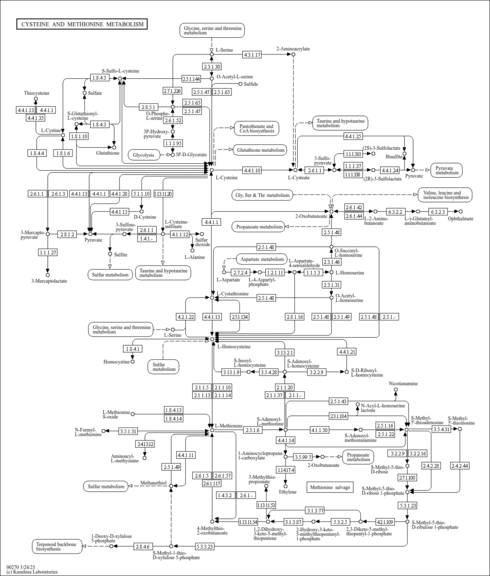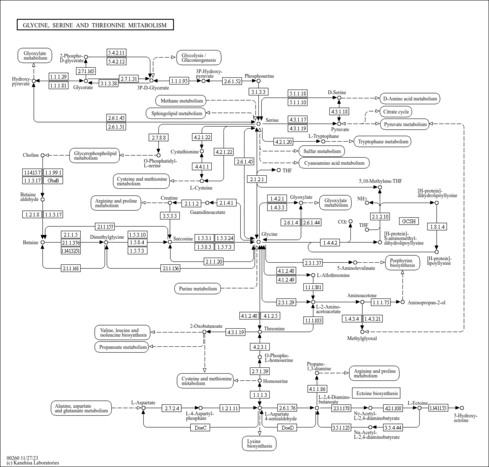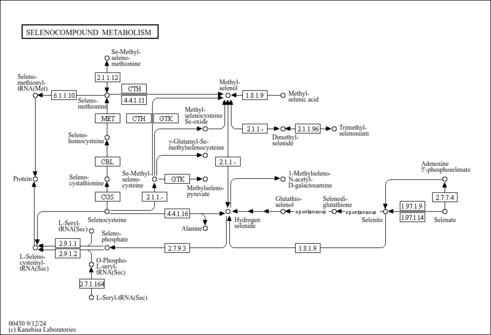| GC-MS Spectra| Spectrum Type | Description | Splash Key | Deposition Date | Source | View |
|---|
| Experimental GC-MS | GC-MS Spectrum - 2-Ketobutyric acid GC-EI-TOF (Pegasus III TOF-MS system, Leco; GC 6890, Agilent Technologies) (Non-derivatized) | splash10-0gbj-1900000000-8daa299f5bc38a7f9b3e | 2014-06-16 | HMDB team, MONA, MassBank | View Spectrum | | Experimental GC-MS | GC-MS Spectrum - 2-Ketobutyric acid GC-EI-TOF (Pegasus III TOF-MS system, Leco; GC 6890, Agilent Technologies) (Non-derivatized) | splash10-014s-1910000000-d01bcd7b41fdcc634eea | 2014-06-16 | HMDB team, MONA, MassBank | View Spectrum | | Experimental GC-MS | GC-MS Spectrum - 2-Ketobutyric acid GC-MS (1 MEOX; 1 TMS) | splash10-000i-9200000000-3b3816ffee5771215904 | 2014-06-16 | HMDB team, MONA, MassBank | View Spectrum | | Experimental GC-MS | GC-MS Spectrum - 2-Ketobutyric acid GC-MS (1 MEOX; 1 TMS) | splash10-000i-6910000000-5b264d5f7e53f3e80b12 | 2014-06-16 | HMDB team, MONA, MassBank | View Spectrum | | Experimental GC-MS | GC-MS Spectrum - 2-Ketobutyric acid GC-MS (2 TMS) | splash10-001i-6950000000-db7f6a0f03a8cce59bae | 2014-06-16 | HMDB team, MONA, MassBank | View Spectrum | | Experimental GC-MS | GC-MS Spectrum - 2-Ketobutyric acid EI-B (Non-derivatized) | splash10-0ftb-0920000000-a6c93d8761ef15f7f7d4 | 2017-09-12 | HMDB team, MONA, MassBank | View Spectrum | | Experimental GC-MS | GC-MS Spectrum - 2-Ketobutyric acid EI-B (Non-derivatized) | splash10-014i-0920000000-406fe70e72dbd9c3f274 | 2017-09-12 | HMDB team, MONA, MassBank | View Spectrum | | Experimental GC-MS | GC-MS Spectrum - 2-Ketobutyric acid GC-EI-TOF (Non-derivatized) | splash10-0gbj-1900000000-8daa299f5bc38a7f9b3e | 2017-09-12 | HMDB team, MONA, MassBank | View Spectrum | | Experimental GC-MS | GC-MS Spectrum - 2-Ketobutyric acid GC-EI-TOF (Non-derivatized) | splash10-014s-1910000000-d01bcd7b41fdcc634eea | 2017-09-12 | HMDB team, MONA, MassBank | View Spectrum | | Experimental GC-MS | GC-MS Spectrum - 2-Ketobutyric acid GC-MS (Non-derivatized) | splash10-000i-9200000000-3b3816ffee5771215904 | 2017-09-12 | HMDB team, MONA, MassBank | View Spectrum | | Experimental GC-MS | GC-MS Spectrum - 2-Ketobutyric acid GC-MS (Non-derivatized) | splash10-000i-6910000000-5b264d5f7e53f3e80b12 | 2017-09-12 | HMDB team, MONA, MassBank | View Spectrum | | Experimental GC-MS | GC-MS Spectrum - 2-Ketobutyric acid GC-MS (Non-derivatized) | splash10-001i-6950000000-db7f6a0f03a8cce59bae | 2017-09-12 | HMDB team, MONA, MassBank | View Spectrum | | Experimental GC-MS | GC-MS Spectrum - 2-Ketobutyric acid GC-EI-TOF (Non-derivatized) | splash10-000i-8900000000-97bab6630de4df095a7f | 2017-09-12 | HMDB team, MONA, MassBank | View Spectrum | | Experimental GC-MS | GC-MS Spectrum - 2-Ketobutyric acid GC-EI-TOF (Non-derivatized) | splash10-000i-9200000000-0ebb2354fe3f935fe177 | 2017-09-12 | HMDB team, MONA, MassBank | View Spectrum | | Predicted GC-MS | Predicted GC-MS Spectrum - 2-Ketobutyric acid GC-MS (Non-derivatized) - 70eV, Positive | splash10-0a6r-9000000000-32269ef3ef778c482f99 | 2016-09-22 | Wishart Lab | View Spectrum | | Predicted GC-MS | Predicted GC-MS Spectrum - 2-Ketobutyric acid GC-MS (1 TMS) - 70eV, Positive | splash10-0adi-9200000000-f92941e9f326d8ccf3e4 | 2017-10-06 | Wishart Lab | View Spectrum | | Predicted GC-MS | Predicted GC-MS Spectrum - 2-Ketobutyric acid GC-MS (Non-derivatized) - 70eV, Positive | Not Available | 2021-10-12 | Wishart Lab | View Spectrum | | Predicted GC-MS | Predicted GC-MS Spectrum - 2-Ketobutyric acid GC-MS (TMS_1_2) - 70eV, Positive | Not Available | 2021-11-05 | Wishart Lab | View Spectrum | | Predicted GC-MS | Predicted GC-MS Spectrum - 2-Ketobutyric acid GC-MS (TBDMS_1_1) - 70eV, Positive | Not Available | 2021-11-05 | Wishart Lab | View Spectrum | | Predicted GC-MS | Predicted GC-MS Spectrum - 2-Ketobutyric acid GC-MS (TBDMS_1_2) - 70eV, Positive | Not Available | 2021-11-05 | Wishart Lab | View Spectrum |
MS/MS Spectra| Spectrum Type | Description | Splash Key | Deposition Date | Source | View |
|---|
| Experimental LC-MS/MS | LC-MS/MS Spectrum - 2-Ketobutyric acid Quattro_QQQ 10V, Negative-QTOF (Annotated) | splash10-0pb9-9600000000-53ebb7164f74d7d92a4d | 2012-07-24 | HMDB team, MONA | View Spectrum | | Experimental LC-MS/MS | LC-MS/MS Spectrum - 2-Ketobutyric acid Quattro_QQQ 25V, Negative-QTOF (Annotated) | splash10-0zfr-5900000000-1db864754705beb79b55 | 2012-07-24 | HMDB team, MONA | View Spectrum | | Experimental LC-MS/MS | LC-MS/MS Spectrum - 2-Ketobutyric acid Quattro_QQQ 40V, Negative-QTOF (Annotated) | splash10-0udi-9800000000-5ba5b9ede5b1bc389b87 | 2012-07-24 | HMDB team, MONA | View Spectrum | | Experimental LC-MS/MS | LC-MS/MS Spectrum - 2-Ketobutyric acid LC-ESI-QTOF (UPLC Q-Tof Premier, Waters) , Negative-QTOF | splash10-0udi-0900000000-bfdcad5bc3ed586bdede | 2012-08-31 | HMDB team, MONA | View Spectrum | | Experimental LC-MS/MS | LC-MS/MS Spectrum - 2-Ketobutyric acid LC-ESI-QTOF , negative-QTOF | splash10-0udi-0900000000-bfdcad5bc3ed586bdede | 2017-09-14 | HMDB team, MONA | View Spectrum | | Experimental LC-MS/MS | LC-MS/MS Spectrum - 2-Ketobutyric acid QqQ 4V, positive-QTOF | splash10-0pb9-9600000000-b10635fbec5572d4d084 | 2020-07-22 | HMDB team, MONA | View Spectrum | | Experimental LC-MS/MS | LC-MS/MS Spectrum - 2-Ketobutyric acid QqQ 8V, positive-QTOF | splash10-0a4i-9100000000-4c5e7d24dca6677e1570 | 2020-07-22 | HMDB team, MONA | View Spectrum | | Experimental LC-MS/MS | LC-MS/MS Spectrum - 2-Ketobutyric acid QqQ 12V, positive-QTOF | splash10-0a4i-9000000000-ded44cfcbe7960954fdf | 2020-07-22 | HMDB team, MONA | View Spectrum | | Experimental LC-MS/MS | LC-MS/MS Spectrum - 2-Ketobutyric acid QqQ 16V, positive-QTOF | splash10-0a4i-9000000000-1b350be7438b08f1946a | 2020-07-22 | HMDB team, MONA | View Spectrum | | Experimental LC-MS/MS | LC-MS/MS Spectrum - 2-Ketobutyric acid QqQ 20V, positive-QTOF | splash10-056r-9000000000-172a175b8b9ebfd5529f | 2020-07-22 | HMDB team, MONA | View Spectrum | | Predicted LC-MS/MS | Predicted LC-MS/MS Spectrum - 2-Ketobutyric acid 10V, Positive-QTOF | splash10-0k9i-9400000000-0061f4635858d851f127 | 2015-05-27 | Wishart Lab | View Spectrum | | Predicted LC-MS/MS | Predicted LC-MS/MS Spectrum - 2-Ketobutyric acid 20V, Positive-QTOF | splash10-0a4r-9100000000-b943445194fb5f8e3a0f | 2015-05-27 | Wishart Lab | View Spectrum | | Predicted LC-MS/MS | Predicted LC-MS/MS Spectrum - 2-Ketobutyric acid 40V, Positive-QTOF | splash10-0a4i-9000000000-bc5920b9bd140be6b06d | 2015-05-27 | Wishart Lab | View Spectrum | | Predicted LC-MS/MS | Predicted LC-MS/MS Spectrum - 2-Ketobutyric acid 10V, Negative-QTOF | splash10-0udi-5900000000-f7dfb4554f0b9e1499c9 | 2015-05-27 | Wishart Lab | View Spectrum | | Predicted LC-MS/MS | Predicted LC-MS/MS Spectrum - 2-Ketobutyric acid 20V, Negative-QTOF | splash10-0a59-9200000000-e54106ad5bf45a9f072c | 2015-05-27 | Wishart Lab | View Spectrum | | Predicted LC-MS/MS | Predicted LC-MS/MS Spectrum - 2-Ketobutyric acid 40V, Negative-QTOF | splash10-0a4i-9000000000-7bbba57578cf720974e3 | 2015-05-27 | Wishart Lab | View Spectrum | | Predicted LC-MS/MS | Predicted LC-MS/MS Spectrum - 2-Ketobutyric acid 10V, Positive-QTOF | splash10-0a4i-9000000000-ca1ed9c5aadcbdabc2a3 | 2021-09-23 | Wishart Lab | View Spectrum | | Predicted LC-MS/MS | Predicted LC-MS/MS Spectrum - 2-Ketobutyric acid 20V, Positive-QTOF | splash10-0a4i-9000000000-aced8e004436190f07b7 | 2021-09-23 | Wishart Lab | View Spectrum | | Predicted LC-MS/MS | Predicted LC-MS/MS Spectrum - 2-Ketobutyric acid 40V, Positive-QTOF | splash10-0a4i-9000000000-a3d7ddf227bd6aa91a54 | 2021-09-23 | Wishart Lab | View Spectrum | | Predicted LC-MS/MS | Predicted LC-MS/MS Spectrum - 2-Ketobutyric acid 10V, Negative-QTOF | splash10-0pb9-9700000000-503296025148ec314383 | 2021-09-25 | Wishart Lab | View Spectrum | | Predicted LC-MS/MS | Predicted LC-MS/MS Spectrum - 2-Ketobutyric acid 20V, Negative-QTOF | splash10-0a4i-9000000000-933b567955b5de5b1744 | 2021-09-25 | Wishart Lab | View Spectrum | | Predicted LC-MS/MS | Predicted LC-MS/MS Spectrum - 2-Ketobutyric acid 40V, Negative-QTOF | splash10-0006-9000000000-7d9db52021fefc87a855 | 2021-09-25 | Wishart Lab | View Spectrum |
NMR Spectra| Spectrum Type | Description | Deposition Date | Source | View |
|---|
| Experimental 1D NMR | 1H NMR Spectrum (1D, 500 MHz, H2O, experimental) | 2012-12-04 | Wishart Lab | View Spectrum | | Experimental 2D NMR | [1H, 13C]-HSQC NMR Spectrum (2D, 600 MHz, H2O, experimental) | 2012-12-04 | Wishart Lab | View Spectrum |
IR Spectra| Spectrum Type | Description | Deposition Date | Source | View |
|---|
| Predicted IR Spectrum | IR Ion Spectrum (Predicted IRIS Spectrum, Adduct: [M-H]-) | 2023-02-03 | FELIX lab | View Spectrum | | Predicted IR Spectrum | IR Ion Spectrum (Predicted IRIS Spectrum, Adduct: [M+H]+) | 2023-02-03 | FELIX lab | View Spectrum | | Predicted IR Spectrum | IR Ion Spectrum (Predicted IRIS Spectrum, Adduct: [M+Na]+) | 2023-02-03 | FELIX lab | View Spectrum |
| Show more...
|---|


